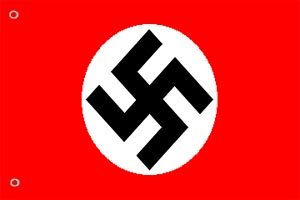At the heart of National Socialism (Nazi) Germany was a love of country and a heart-felt desire to restore and promote all things German. The renewed religion of the north countries, the Nordic (the word is derived from Nord, German and Scandinavian for north), must be put back in its correct place. As a result, the runes and rune symbols became very important in the life and events of Nazi Germany. See Norse Rune Symbols and the Third Reich.
The Holy Nation of Odin traces the history of Tiu, the son of Odin and Frigga or Freya. He is the god of martial honor, courage, defense and victory, bravest of the gods and one of the twelve principal deities of Asgard. He is portrayed as the one-handed warrior.
By the way, the practice of Odinism or the Nordic faith continues to the present day. As the home page of the Holy Nation of Odin says, we all should be familiar with it because of the very names of our week: Sunna (Sunday), Manni (Monday), Tiu/Tyr (Tuesday), Wodan/Odin (Wednesday), Thor (Thursday) and Frigga/Freya (Friday). Note also that the practice of putting up a Christmas tree can be traced to this those who followed the Nordic faith and decorated trees to attract ancestral spirits to accept their gifts.
But back to Tiu and his runic symbol. Runes were always considered symbols of great power. The word rune itself means 'mystery'. This was especially true when reading and writing were not common, so the ability to represent ideas in symbolic form was a mystery to most. Thus these symbols became a means of communication between the seen and the unseen, between the visible world of men and the invisible spirit realm, the realm of the gods, the mighty ones.
In the view of this and other nature religion, everything is divine and alive. The Spirit and the spirits are everywhere. So the Nordic or Germanic priests and priestesses used the runes to divine or read the messages of the spirits. More on this another time.
In Nazi Germany the Tyr or Tiu rune was also known as the Kampf-Rune (Battle rune) or the Pfeil-Rune (Arrow rune). It symbolized leadership in battle and was widely used by various young people organizations. It was used as a symbol for leadership schools (Reichsführerschulen) of Hitler's brownshirts, the SA (Sturmabteilung), the Nazi party's paramilitary wing. Upon graduation from leadership school, brownshirts were permitted to wear the Tyr symbol on the upper left arm. It was also the badge of the SS (Schutzstaffel or 'protective squadron'). The SS broke off from the SA in 1934. The graves of the SS were marked with the Tyr symbol rather than the Christian cross.
To the present the Tyr rune is common among white supremacists and Neo-Nazi hate groups.


No comments:
Post a Comment